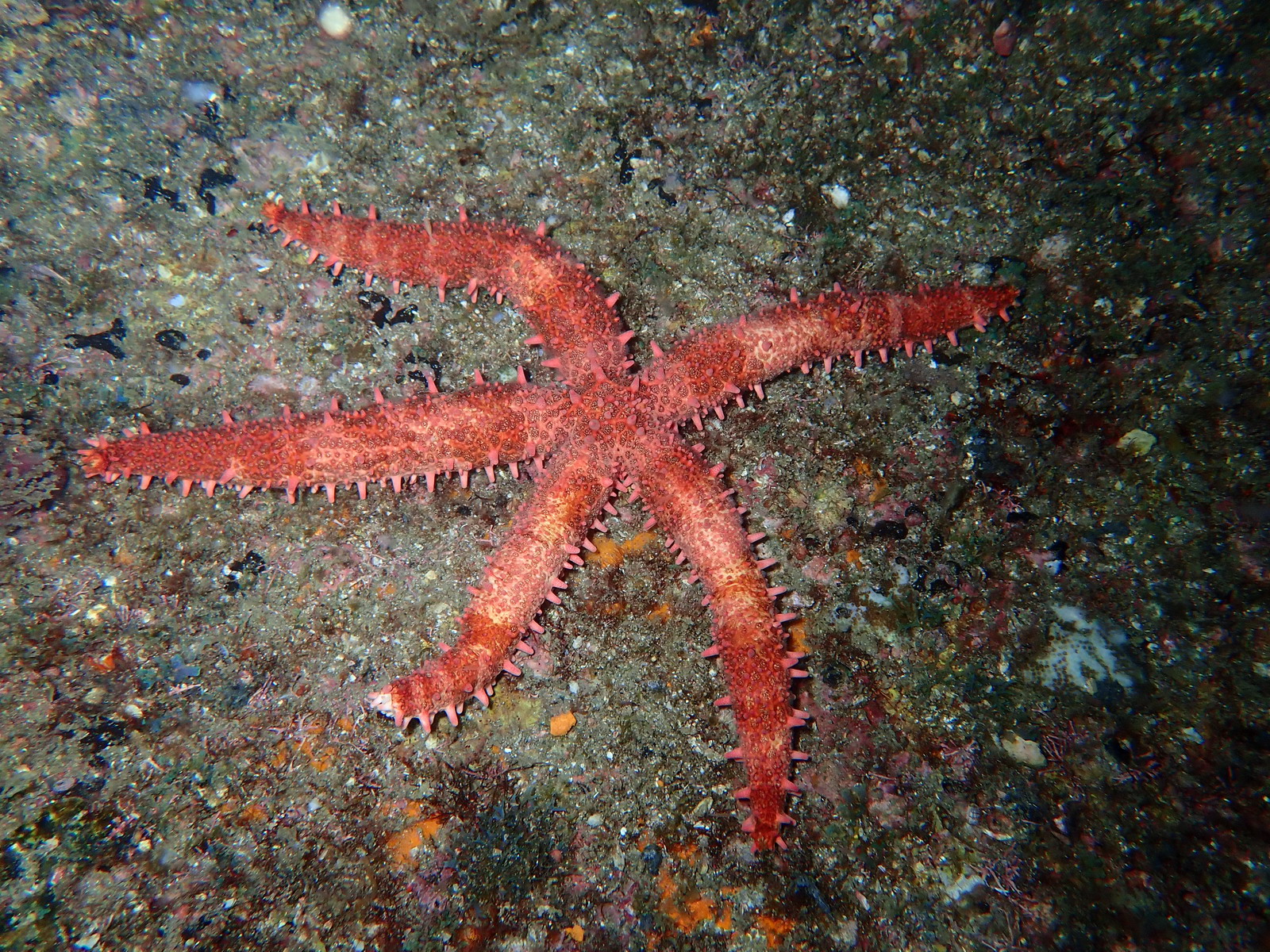Mithrodia Bradleyi on:
[Wikipedia]
[Google]
[Amazon]
''Mithrodia bradleyi'', known as Bradley's sea star, is a
 Bradley's sea star has five arms that are banded in lighter and darker shades of red or red-brown. The disk is small. The arms are covered with many small bumps and fewer, more prominent spines. The spines are arranged in rows, including a row that runs right along the top of each arm, and typically two more rows that run the length of the arms on either side. The arms are rounded, almost circular in cross-section. The sea star can obtain a diameter of .
Bradley's sea star has five arms that are banded in lighter and darker shades of red or red-brown. The disk is small. The arms are covered with many small bumps and fewer, more prominent spines. The spines are arranged in rows, including a row that runs right along the top of each arm, and typically two more rows that run the length of the arms on either side. The arms are rounded, almost circular in cross-section. The sea star can obtain a diameter of .
species
In biology, a species is the basic unit of classification and a taxonomic rank of an organism, as well as a unit of biodiversity. A species is often defined as the largest group of organisms in which any two individuals of the appropriate s ...
of sea star
Starfish or sea stars are Star polygon, star-shaped echinoderms belonging to the class (biology), class Asteroidea (). Common usage frequently finds these names being also applied to brittle star, ophiuroids, which are correctly referred to ...
. It was first described to science by Addison Emory Verrill in 1870. It was named after Frank Howe Bradley
Frank Howe Bradley (September 20, 1838 – March 27, 1879) was an American geologist.
Bradley, son of Abijah and Eliza Collis (Townsend) Bradley, was born in New Haven, Conn., September 20, 1838
He graduated from Yale College in 1863. Through h ...
, who collected, in Panama
Panama ( , ; es, link=no, Panamá ), officially the Republic of Panama ( es, República de Panamá), is a transcontinental country spanning the southern part of North America and the northern part of South America. It is bordered by Cos ...
, the type specimen
In biology, a type is a particular wiktionary:en:specimen, specimen (or in some cases a group of specimens) of an organism to which the scientific name of that organism is formally attached. In other words, a type is an example that serves to a ...
described by Verrill.
Description
 Bradley's sea star has five arms that are banded in lighter and darker shades of red or red-brown. The disk is small. The arms are covered with many small bumps and fewer, more prominent spines. The spines are arranged in rows, including a row that runs right along the top of each arm, and typically two more rows that run the length of the arms on either side. The arms are rounded, almost circular in cross-section. The sea star can obtain a diameter of .
Bradley's sea star has five arms that are banded in lighter and darker shades of red or red-brown. The disk is small. The arms are covered with many small bumps and fewer, more prominent spines. The spines are arranged in rows, including a row that runs right along the top of each arm, and typically two more rows that run the length of the arms on either side. The arms are rounded, almost circular in cross-section. The sea star can obtain a diameter of .
Distribution
Bradley's sea star lives in the eastern Pacific Ocean fromMexico
Mexico (Spanish: México), officially the United Mexican States, is a country in the southern portion of North America. It is bordered to the north by the United States; to the south and west by the Pacific Ocean; to the southeast by Guatema ...
to Chile
Chile, officially the Republic of Chile, is a country in the western part of South America. It is the southernmost country in the world, and the closest to Antarctica, occupying a long and narrow strip of land between the Andes to the east a ...
, including the Gulf of California
The Gulf of California ( es, Golfo de California), also known as the Sea of Cortés (''Mar de Cortés'') or Sea of Cortez, or less commonly as the Vermilion Sea (''Mar Bermejo''), is a marginal sea of the Pacific Ocean that separates the Baja Ca ...
. It is also found in the Galapagos Islands. It lives on rocky bottoms and coral reefs from the intertidal zone
The intertidal zone, also known as the foreshore, is the area above water level at low tide and underwater at high tide (in other words, the area within the tidal range). This area can include several types of habitats with various species o ...
to deep. This animal lives in a water temperature band from to . This temperature range is cooler than a typical tropical fish tank, so this sea star is not collected for the aquarium trade.
References
{{Taxonbar , from = Q3044654 Mithrodiidae Animals described in 1870